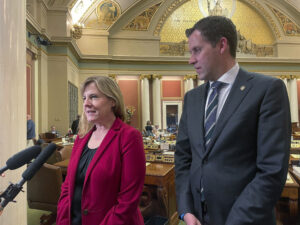Minneapolis Policeman Charged in Shooting of Australian Woman
Officer Mohamed Noor is jailed on third-degree murder and second-degree manslaughter charges in the death of Justine Damond, who had called 911 to report a possible sexual assault in the alley behind her home.MINNEAPOLIS—A Minneapolis police officer who shot and killed an unarmed Australian woman in July was booked into jail Tuesday on charges of third-degree murder and second-degree manslaughter.
Officer Mohamed Noor turned himself in Tuesday after a warrant was issued for his arrest. He shot Justine Ruszczyk Damond, a 40-year-old life coach, on July 15 minutes after she called 911 to report a possible sexual assault in the alley behind her home. Damond’s death drew international attention, cost the police chief her job and forced major revisions to the department’s policy on body cameras.
Hennepin County Attorney Mike Freeman planned a Tuesday afternoon news conference to discuss the charges. The criminal complaint remained sealed by midday Tuesday, but according to the jail roster, Noor was booked on a third-degree murder charge for perpetrating an eminently dangerous act while showing a “depraved mind.” The second-degree manslaughter charge alleges he acted with “culpable negligence creating unreasonable risk.”
If convicted of third-degree murder, he could face a maximum of 25 years in prison, though the presumptive sentence is 12 ½ years. The second-degree manslaughter charge carries a maximum sentence of 10 years in prison, but the presumptive sentence is four years.
The jail set bail at $500,000, according to jail records.
Noor has not spoken publicly about the case and declined to answer questions from investigators. His attorney, Thomas Plunkett, confirmed Noor turned himself in, but had no other immediate comment.
Damond’s father, John Ruszcyzk, and her fiance, Don Damond, issued a joint statement on behalf of both families, saying they applauded the decision to charge Noor “as one step toward justice for this iniquitous act.” They said they are pleased that the investigation appeared diligent and thorough, and they hope for a conviction.
“No charges can bring our Justine back. However, justice demands accountability for those responsible for recklessly killing the fellow citizens they are sworn to protect, and today’s actions reflect that,” the statement said.
An officer who was with Noor at the time of the shooting, Matthew Harrity, told investigators that he was startled by a loud noise right before Damond approached the driver’s side window of their police SUV. Harrity, who was driving, said Noor then fired his weapon from the passenger seat. Damond died of a gunshot wound to the abdomen.
The officers did not turn on their body cameras until after the shooting, and there was no squad camera video of the incident.
The lack of video was widely criticized, and Damond’s family members were among the many people who called for changes in procedure, including how often officers are required to turn on their cameras.
The shooting also prompted questions about the training of Noor, a two-year veteran and Somali-American whose arrival on the force had been celebrated by city leaders and Minnesota’s large Somali community. Noor, 32, had trained in business and economics and worked in property management before becoming an officer.
Then-Chief Janee Harteau defended Noor’s training and said he was suited to be on the street, even as she criticized the shooting itself. But Harteau — who was on vacation when the shooting happened and didn’t make her first public appearance until several days after the shooting — was forced out soon after by Mayor Betsy Hodges, who said she had lost confidence in the chief.
Harteau’s replacement, Medaria Arradondo, quickly announced a policy change requiring officers to turn on their body cameras in responding to any call or traffic stop. Recent reports show the department is not yet in full compliance.
Damond’s shooting was the third high-profile police shooting in Minnesota in recent years in which a prosecutor made a charging decision rather than relying on a grand jury, a process criticized for secrecy and for the rarity of officers being charged. But in this case, Freeman convened a grand jury to investigate, but maintained the decision to charge would be his.
The move came about a month after Freeman was captured on video at a holiday reception in December, complaining that investigators hadn’t brought him enough evidence to charge Noor. Freeman apologized just a few days later, saying he shouldn’t have discussed the case in detail in public. About a month later, dozens of officers received subpoenas to testify before the grand jury.
Noor has been on paid leave since the shooting.
___
Associated Press writers Doug Glass, Jeff Baenen and Steve Karnowski contributed to this report from Minneapolis.
Your support matters…Independent journalism is under threat and overshadowed by heavily funded mainstream media.
You can help level the playing field. Become a member.
Your tax-deductible contribution keeps us digging beneath the headlines to give you thought-provoking, investigative reporting and analysis that unearths what's really happening- without compromise.
Give today to support our courageous, independent journalists.






You need to be a supporter to comment.
There are currently no responses to this article.
Be the first to respond.